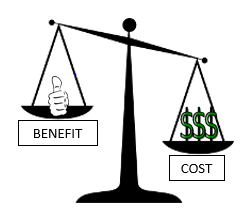Direct losses are measured or estimated statistically or by a priori judgment. Actuarial fire-loss data collected nationally or for a particular industry may be used, pro-viding it is adequately specific and the collection mecha-nism is reliable. More often, an experienced judgment of potential losses is made, sometimes referred to as the max-imum probable loss (MPL).
Indirect losses, if considered, are much more difficult to appraise. A percentage or multiple of direct losses is sometimes used. However, when indirect loss is an im-portant decision parameter, a great deal of research into monetary evaluation may be necessary. Procedures for valuing a human life and other indirect losses are dis-cussed in Ramachandran.3
In the measurement of benefits, it is appropriate to adjust for utility or disutility which may be associated with a fire loss.
Costs may be divided into two major categories:
(1) costs of private fire protection services, and (2) costs of public fire protection services. In either case, cost esti-mates will reflect the opportunity cost of providing the service. For example, the cost of building a fire-resistive structure is the production foregone due to the diversion of labor and resources to make such a structure. Similarly, the cost of a fire department is the loss of other commu-nity services which might have been provided with the resources allocated to the fire department.


